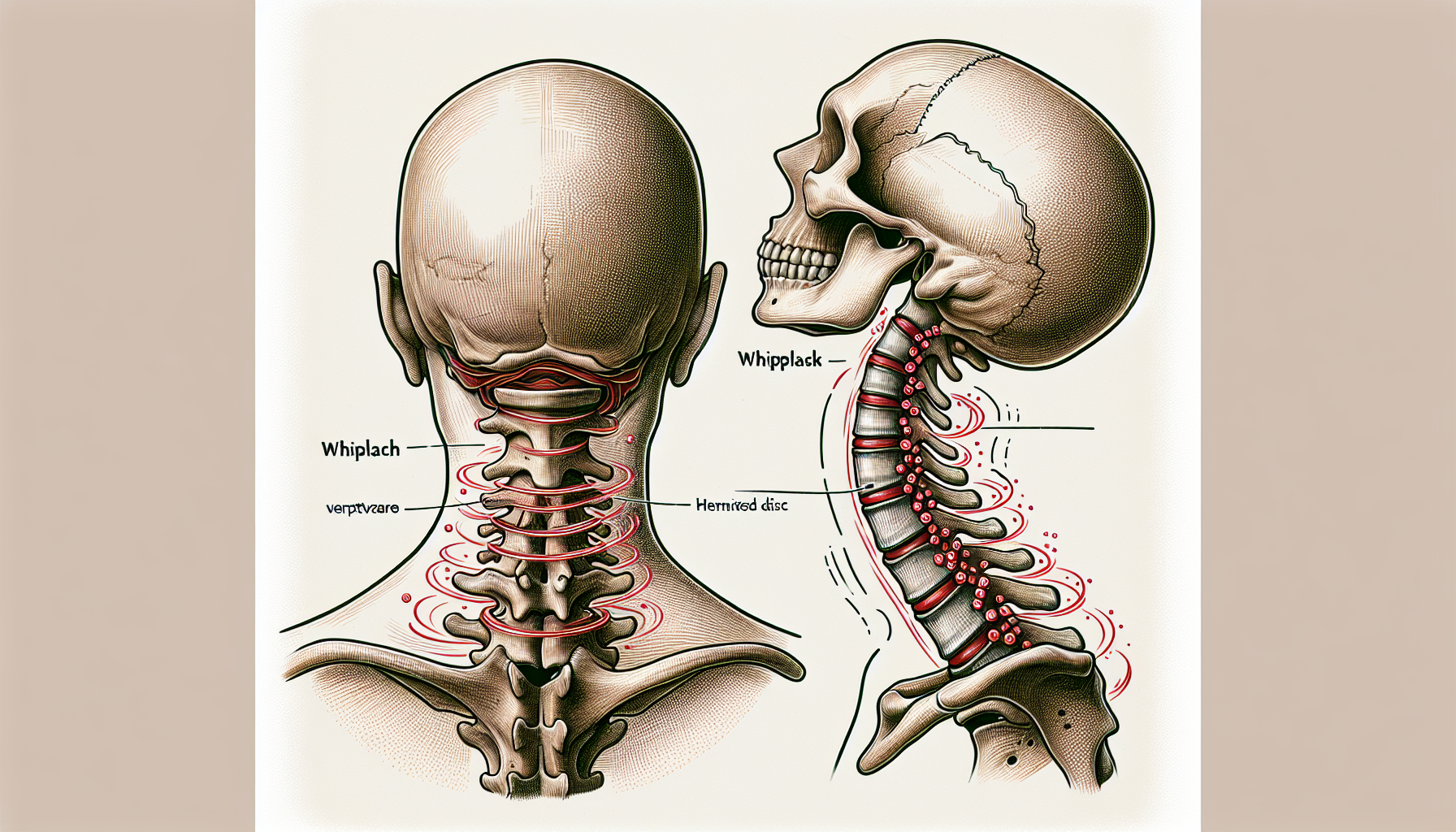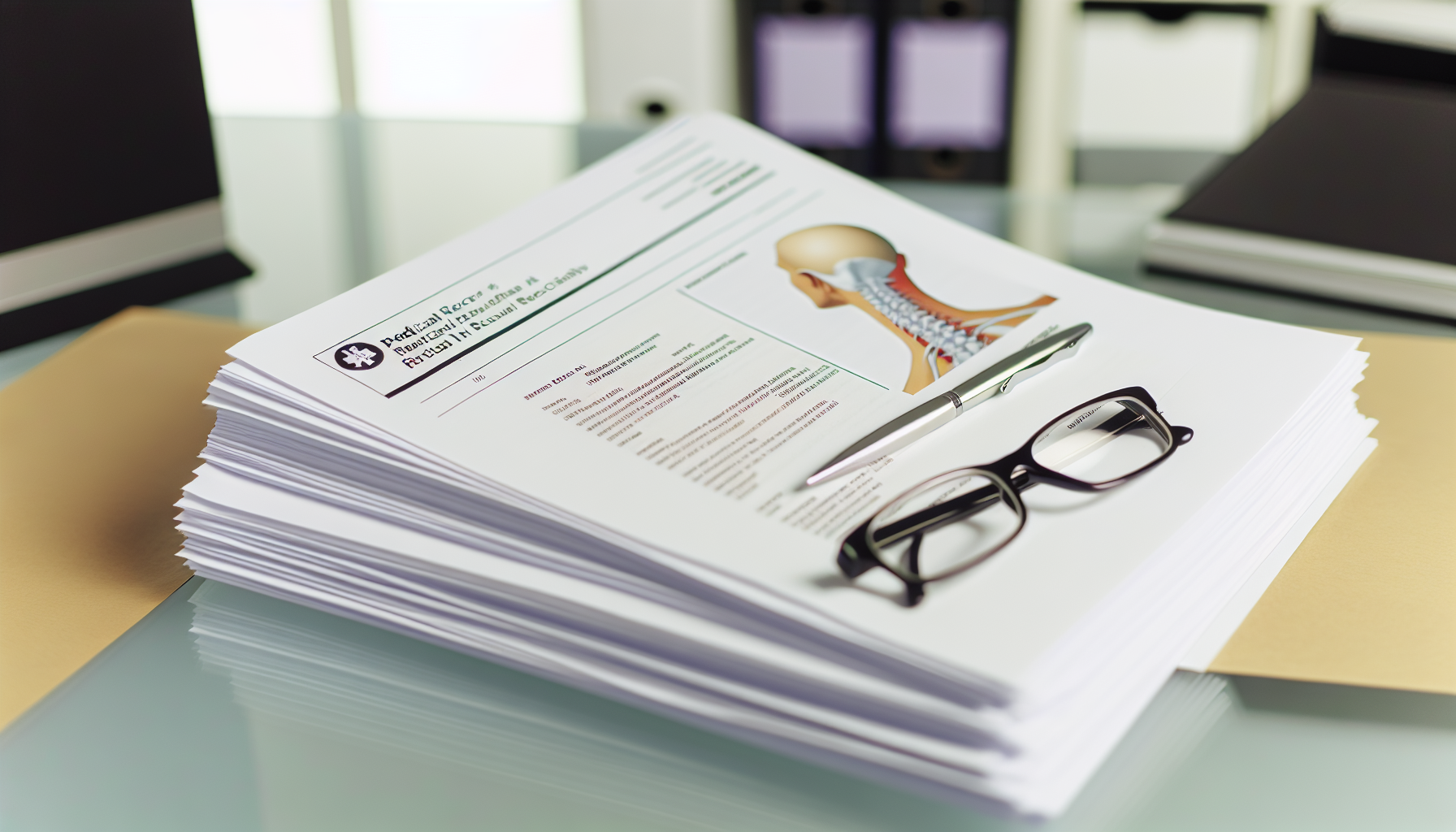Experiencing neck pain after a car accident can signal a range of issues that could affect both your health and any legal claims. This article concisely walks you through the recognition of warning signs, why seeking immediate medical assistance is crucial, and how these decisions can influence a settlement. Learn the essential steps to address neck pain following an accident and secure your rightful compensation.
Key Takeaways
- Early recognition of neck pain symptoms post-car accident is crucial for health and compensation, including seeking medical attention for proper injury documentation to support potential claims.
- Neck injuries from car accidents vary in severity from whiplash to spinal cord injuries, each requiring specific treatments and integral to personal injury claims for settlement calculations.
- Professional legal representation assists in navigating personal injury claims by managing documentation, negotiating with insurance companies, proving liability, and maximizing settlement amounts.
Recognizing Neck Pain After a Car Accident
The moments following a car accident can be a whirlwind of emotions and confusion. Amidst the chaos, it’s easy to overlook the signs of a neck injury. However, recognizing these symptoms early on can significantly impact your health and potential compensation.
Neck pain following a car accident can manifest in various ways, from minor discomfort to debilitating pain. These symptoms may be a sign of more severe injuries, such as whiplash, herniated discs, or even spinal cord injuries. Therefore, seeking immediate medical attention can help prevent further complications and allow for proper documentation of injuries, which can influence potential compensation claims.
Common Symptoms of Neck Pain
After a car accident, you might experience the following symptoms of neck pain:
- Stiff neck
- Limited range of motion
- Headaches
- Muscle spasms
These symptoms should not be taken lightly and should be addressed by a medical professional.
While some discomfort might seem minor, it’s important to pay attention to more severe symptoms. Indicators of a more serious back or neck injury, such as a severe neck, include:
- Sharp, stabbing pain
- Pain radiating to the shoulders or arms
- Difficulty bending the head backward
- Persistent neck pain unresponsive to rest or over-the-counter medications
Should you notice any of these symptoms, it’s essential to get further evaluation from a healthcare professional. These symptoms could be pivotal in determining a car accident settlement.
Potential Causes of Neck Pain
Identifying the underlying cause of your back and neck injuries marks a considerable milestone towards recovery and securing compensation. Whiplash, one of the most common neck injuries resulting from car accidents, is caused by the forceful and rapid back-and-forth movement of the neck. This movement can strain:
- muscles
- discs
- nerves
- other structures in the neck
leading to significant discomfort.
Herniated discs are another potential cause of neck pain. The forceful impact of a car accident can lead to a herniated disc by damaging the discs, or the whiplash motion commonly associated with car accidents can also contribute to herniation in the cervical spine. This contributes to neck pain following an accident and can be a factor in determining a back injury settlement.
When to Seek Medical Attention
The moments after a car accident can be a blur, and you might not immediately realize the extent of your injuries. You might feel fine at the scene, only to experience discomfort several hours or even days later. This delay underscores the necessity of seeking medical attention promptly after a car accident, irrespective of how you feel at the moment.
The potential consequences of neglecting symptoms of neck pain can be far-reaching, extending beyond physical discomfort to emotional challenges such as depression and anxiety. Immediate medical attention is necessary if you observe persistent or escalating neck pain. Ignoring these symptoms could lead to more serious complications down the line, impacting not only your health but also the potential compensation you could receive for your injuries.
Types of Neck Injuries Resulting from Car Accidents

Neck injuries, as well as neck or back injuries, stemming from car accidents, can range from minor to severe, with some potentially resulting in long-term disability. Each neck injury type exhibits different symptoms and necessitates varied treatments, emphasizing the importance of understanding the specific neck injury you’re contending with.
From whiplash to herniated discs to spinal cord injuries, each injury type carries a unique set of symptoms and treatment options. Understanding the details of these injuries can help you navigate your personal injury claim and potentially increase your chances for a more substantial settlement.
Whiplash
Whiplash is one of the most common injuries sustained in car accidents. This injury results from the forceful and rapid back-and-forth movement of the neck, similar to the cracking of a whip.
Whiplash symptoms can range from:
- neck pain and stiffness
- headaches
- dizziness
- numbness in the arms or hands
These symptoms can impact your ability to perform daily activities and can significantly affect your quality of life. Prompt diagnosis and suitable treatment are fundamental to manage these symptoms effectively and guarantee a seamless recovery process.
Herniated Discs
A herniated disc occurs when the soft center of a spinal disc pushes through a crack in the tougher exterior casing. This condition can result from the forceful impact of a car accident or the whiplash motion commonly associated with such incidents.
Symptoms of a herniated disc may include:
- Neck, back, arm, or leg pain
- Numbness
- Tingling
- Muscle weakness
Depending on the severity of the herniation, treatment options may range from conservative measures such as physical therapy to surgical intervention in instances of nerve impingement and weakness.
Spinal Cord Injuries
A spinal cord injury is arguably one of the most severe injuries one can sustain in a car accident. These injuries occur when damage impacts the cervical, lumbar, or thoracic areas of the spine, potentially leading to impairment, interference, or severance of the spinal cord.
Symptoms that may indicate a spinal cord injury include extreme back pain, weakness, incoordination, numbness, or loss of sensation and control in various parts of the body. Long-term complications stemming from spinal cord injuries can be severe, possibly resulting in complete paralysis, loss of movement, persistent severe pain, and permanent nerve damage.
The Importance of Proper Documentation

When it comes to personal injury claims, documentation is key. Accurate documentation aids in validating your claim, illustrating the severity of your injuries, and maintaining a lucid record of your medical treatments and costs.
This documentation can be categorized into three main types: medical records, accident reports, and personal documentation. Each type of documentation serves a unique purpose and plays a critical role in building a strong personal injury claim.
Medical Records
Medical records are an essential part of your personal injury claim. These records provide a comprehensive picture of your injuries, the treatments you’ve received, and your recovery progress.
From the initial diagnosis to subsequent medical visits and prescribed medications, medical records document every step of your journey toward recovery. These records act as proof of your injuries and treatments, which can substantially affect the final settlement amount.
Accident Reports
Accident reports, typically prepared by law enforcement agencies, provide a detailed account of the car accident. These reports include specific details such as the date, time, and location of the crash, the identities of the parties involved, and the conditions at the time of the accident.
These reports are vital as they serve as crucial evidence of the accident and can help determine fault. These reports offer the required groundwork to bolster your claim and ascertain liability.
Personal Documentation
Personal documentation, such as a pain journal or photographs of the accident scene, can provide a more personal perspective on your injuries. These forms of documentation can help illustrate the impact of your injuries on your daily life, further substantiating your claim.
A pain journal can be particularly helpful in tracking the progression of your symptoms and treatment. Similarly, photographs of the accident scene, visible injuries, and any property damage can provide valuable evidence for your claim.
Calculating Damages for Neck Pain Settlements
Once you’ve gathered all the necessary documentation, it’s time to calculate the damages for your neck pain settlement. This calculation takes into account various factors, including medical expenses, lost wages, and pain and suffering. By considering these factors, you can estimate the average settlement amount for your case.
Each of these factors represents a different aspect of the impact of your neck injury. Together, they paint a comprehensive picture of the total cost of your injury, both financial and emotional.
Medical Expenses
Medical expenses are a significant part of any personal injury claim. These expenses include not only the costs of immediate medical care immediately following the accident but also future medical costs for ongoing treatments and rehabilitation.
It’s important to keep thorough records of all your medical expenses, including:
- Hospital bills
- Prescription medications
- Doctor visits
- Lab tests
- Physical therapy sessions
These records establish a transparent record of your medical expenses, reinforcing your compensation claim.
Lost Wages and Earning Capacity
In addition to medical expenses, your injury may also impact your ability to work. Lost wages account for the income you’ve lost due to your injury, while lost earning capacity represents potential future losses due to your injury’s impact on your ability to work.
Though the calculation of these losses can be intricate, it is a vital step in ensuring fair compensation for your injuries. In many cases, a skilled personal injury attorney can help you navigate this process.
Pain and Suffering
Beyond the tangible costs of medical expenses and lost wages, neck injuries can also result in significant pain and suffering. This category of damages compensates for the physical and emotional distress caused by your injury.
Pain and suffering can be difficult to quantify, but they are an important part of the compensation equation. A personal injury attorney can help you navigate this complex aspect of your claim, ensuring that you receive fair compensation for all aspects of your injury.
Working with a Personal Injury Attorney
Navigating the complexities of a personal injury claim can be overwhelming, especially when you’re also dealing with the physical and emotional toll of a neck injury. That’s where a personal injury attorney comes in.
A seasoned attorney can help you with the following:
- Steer you through the entire process, including documentation gathering, damage calculation, and negotiation with insurance companies
- Help you prove the other party’s liability
- Maximize your average settlement value
- Ensure you receive the compensation you deserve
Negotiating with Insurance Companies
When it comes to negotiating with insurance companies, having an experienced personal injury attorney by your side can make a significant difference. Insurance companies frequently attempt to reduce their payouts. Without a robust advocate, you might settle for an amount lower than what you rightfully deserve.
At JML Injury Law, our attorneys are experienced in handling insurance companies. We’re skilled in:
- Reading between the lines of their proposals
- Understanding the implications
- Effectively negotiating on your behalf to secure a more favorable settlement.
Proving Liability
Establishing liability in a car accident can be a convoluted process. It requires gathering ample evidence, identifying responsible parties, and establishing negligence. Our personal injury attorney at JML Injury Law is experienced in all these areas and can help you build a strong case for liability.
From obtaining medical records to securing accident reports and interviewing witnesses, we employ comprehensive methods to analyze the incident and build a compelling case demonstrating the liability of the at-fault party.
Maximizing Settlement Value
At JML Injury Law, our objective is to secure the highest possible neck injury settlement for you. We work diligently to:
- Facilitate immediate medical care
- Preserve crucial evidence
- Accurately assess the value of your claim
- Document all losses
- Advocate assertively to secure fair compensation for your injuries.
Frequently Asked Questions
How Long Does Neck Pain Last After A Car Accident?
Neck pain after a car accident can last from a few days to a few weeks in most cases, but more severe injuries may take longer to heal and can lead to long-term damage. It’s important to see a doctor and consider legal options to ensure proper treatment and compensation.
What Are Delayed Symptoms After Car Accident?
It’s common to experience delayed symptoms after a car accident, such as soreness in your neck or shoulders, abdominal pain, or headaches. These symptoms may appear hours or days after the accident.
What Is The Most Common Neck Injury In A Car Accident?
The most common neck injury in a car accident is whiplash, which occurs most frequently after a rear-end collision. It is caused by the head jerking back and forth or side to side during the impact.
What Are The Common Symptoms Of Neck Pain Following A Car Accident?
The common symptoms of neck pain following a car accident include neck pain, stiffness, limited range of motion, headaches, dizziness, and numbness or tingling in the arms or hands. Seek medical attention if you experience any of these symptoms.
Contact Our Frisco Personal Injury Attorney Now
Dealing with a neck injury from a car accident can be a challenging journey, but understanding the process can make it less daunting. From recognizing neck pain and understanding the types of neck injuries to calculating damages and negotiating with insurance companies, each step is crucial. Remember, you don’t have to navigate this journey alone. At JML Injury Law, we’re here to guide you every step of the way.



